You are reading the older HTML site
Positive Feedback ISSUE
43may/june 2009
Sonic Satori - Chasing Inexpensive
Ways to Enhance Our Digital Music Libraries
by Michael Mercer
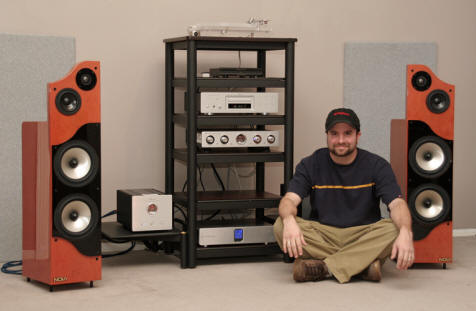
A venture into USB DACs, and the possibilities when marrying your hi-fi system to your computer.
The purists have to get over it. We live in a digital world (predominantly anyway, and yes I still love vinyl). Therefore we must explore the sonic possibilities when integrating our digital/hard drive music libraries into our most cherished home hi-fi systems. Simply put: the time is now, and we are obligated to help each other find ways in which to embrace new technology, and perhaps push it forward as the result of our inclusion. Plus: I'm not sure about you, but I sometimes find it difficult to even locate the physical release of an artist I'm into, or, other times the music hasn't even been released in a physical format. Well, being a music lover; I dig that I can still find (and have more access to than ever actually) great music, and if that means getting it digitally, so be it. Not everything is an mp3 file. There are digital copies everywhere that sound terrific, so why imprison them in your computer? Of course there are terrible (MP3, when done poorly) digital files out there as well, but are there not terrible analog releases? C'mon man. Let's find a way to get those files over to your beloved hi-fi system.
Meandering thoughts aside; most people agree: the first, most important obstacle we must bypass in order to successfully couple your MAC or PC to your hi-fi is the audio output of the computer itself. If you make the mistake of lazily connecting a stereo mini to RCA from the computer you are relying solely on the computer's internal DAC. Not good. We learned just how important DACs were during the dawn of the CD era. Out-board transports and DACs, as opposed to one-box players (yes, some are very good), became the path to digital nirvana. OK, well, not Nirvana, but closer to real music! Fortunately for us there are plenty of solid little (and some not so little) companies coming up with splendid diminutive DACs for both MACs and PCs (and even for iPods; bypassing its internal DAC for on-the-go performance). This way our computers/music libraries act simply as the digital source, and with a decent DAC you are positioned well enough to enjoy great sound through your own stereo system.
I gathered a couple of reasonably priced USB DACs, intending to put them into action on both my MAC G4 and desktop PC (with five hundred gigs of music on an external hard drive as well). I then used these DACs to drive my two-channel reference system in the office/living room. The original plan of attack was to do a shoot-out, but thanks to a suggestion from my commander-in-chief Dave Clark I have decided to do a round-up of sorts: running down the function and merits of each component. They are, after all, different in their execution and features, and so they deserve their own space for which we can dive into the things they do, and how effectively they work. Here we go!
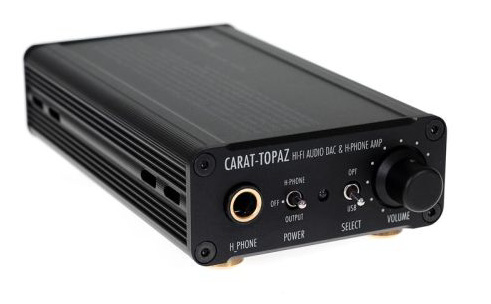
Styleaudio Carat-Topaz USB DAC/Headphone Amp: $449
This little unit packs a couple of thoughtful features the others here in the mix do not (this is not a dig at the other DACs, rather a compliment to the folks at Styleaudio). For one we have an additional input provided via optical cable. This is a simple, yet strategic choice as it allows the user to utilize the Topaz as an out-board DAC on any player with an optical digital out. Have an inexpensive universal player, but not impressed with its CD sound? Here's an inexpensive way to improve the sonic performance of your budget gear. The folks at Styleaudio know that a USB input alone limits the application of their device, and in this day and age that can kill a component before it meets the market. There is also a headphone amp on-board with a quarter inch output and volume pot on the front panel – both a nice touch. Another carefully thought-out feature is the RCA stereo output jacks. If you've come to know the musical signature of your choice in interconnects, then you'll be psyched to know that you can use them with the Topaz.
I find some manufacturers forget that we hi-fi-ers tend to pick a certain cable and stick with it, therefore introducing a component with its own output cables, sometimes varying in quality, can have an adverse effect on the components ability to integrate into an already established system. In addition; when you put an alien set of cables on an already unfamiliar piece of equipment it is difficult to discern whether what you are hearing is the result of the unit itself, or the interconnect (and of course it is both, but how do we know what is doing what)? I was able to throw my current reference Nordost Heimdall interconnects on board and knew instantly what I was hearing.
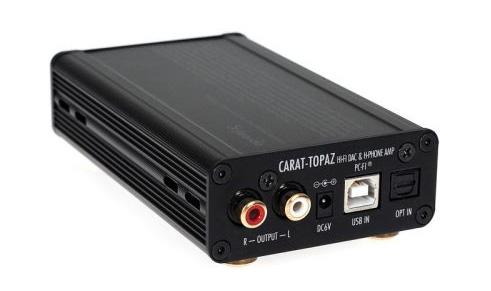
This little box, quite frankly, blew our doors off (me and my beloved wifey Alexandra, who has terrific ears by the way, and is often my acid test) with its level of performance and features at this price point. The initial set-up was painless: plug it into your computer's USB output, select the device in your "sound" settings, and the music flows. The overall build quality is stout for a component this size: 75mmW x 30mmH x 126mmD. The housing is aluminum (black) with brass coupling feet for vibration control. The main DAC is a Burr-Brown PCM1792 / 24-bit 192kHz sampling Advanced-Segment audio stereo DAC. They covered the jitter factor with a Cirrus Logic CS8416 digital controller with Low Jitter Clock Recovery and a 32kHz to 192kHz sample frequency range. The headphone opamps are Burr-Brown OPA2134 (x 2pcs). Clearly they did a bit of research before arriving at their final decisions for the guts of this thing. The power is supplied by 6 volt DC power supply.
Though the break-in time is greater than the fifty hours they suggest (its actually around a hundred hours, thanks to Lee at Cryoparts.com for that most helpful tip) the end result should surprise you. The Topaz did not disappoint fresh out of the box either. The music did seem somewhat lean at first; its lower midrange and bottom end articulation was a bit sparse, but those frequencies quickly morphed into that of being full-bodied over a period of a couple of days.
My first surprise came at the ability of the Topaz to capture the transient speed, as well as the natural decay of the hi-hat and other percussion on Patty Griffin's "Standing." This is one of my reference tracks for imaging and overall sound staging. There is a dark, almost liquid-like space surrounding Griffin in this song, and the bass seems to come from the outer depths when reproduced correctly. The Topaz nailed it after it burned in. It had no problem with the spacey sounds and wild stereo panning on Radiohead's Kid A. Nigel Godrich used everything for effect on this record, even a bit of distortion in places, for added texture. Some digital systems masked these exquisite little details. Not the Topaz. I felt like it did the album justice, which is no small feat.
We put the additional optical input to use on our Yamaha DV-S5751 CD/DVD player. This is a bread and butter player that is used occasionally for CD playback and for DVD videos in our work area. We bought the thing for ninety nine bucks (it's a steal by the way). The Topaz changed the sound of the unit completely! Before we went to the outboard DAC we did some listening to the players internal DAC (though we are already quite familiar with its sound) and were floored by the difference in the size of the soundstage once we clicked over to the Topaz. We gained both width and depth, not to mention the increased information retrieval. On Ben Harper's song "Forever" on Welcome to the Cruel World there is a noticeable noise floor, which always sounded like tube noise to me. The song, and album for that matter, is so gorgeous the noise disappears into the magic of the music. Well, without the Topaz this noise (which is part of the recording itself) did in fact disappear, and so did the air around Harper and his guitar. The difference was astounding. If your budget kept you from spending big bucks on your digital front end, here is a way to increase its musicality without breaking the bank.
Overall I was very impressed with the Topaz, and would recommend it to anybody looking to squeeze more performance from their MAC or PC's music library. We hope to add it to our office system for good. That is possibly the best compliment I can bestow upon this little gem.
*I will be reviewing the headphone amp section, as well as doing a follow-up on the piece including some new USB cables by the Locus Design Group, as part of an upcoming accessories review here in PFO.
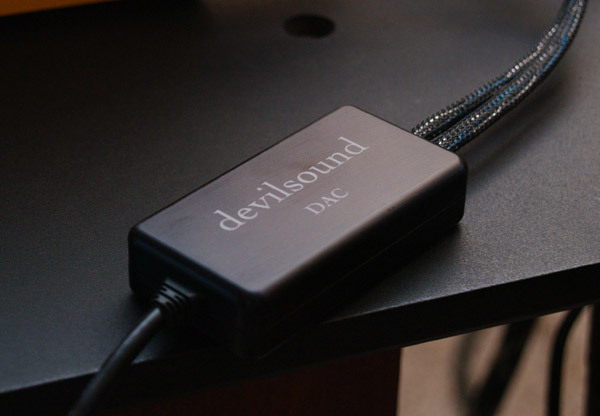
Devilsound DAC Digital Audio Cable: $299
Our chief Dave Clark has already rendered his opinion on this surprising little engineering marvel (please see https://positive-feedback.com/Issue41/ramblings_devilsound_virtue.htm to read his thoughts). So when I was given the opportunity to hear it for myself I had to jump on it. Plus it was already burned in for me! I'm referring to the Devilsound DAC here as a "DAC Digital Audio Cable" because Devilsound themselves call it that on their website, and, well, because this unit is what we would call an "online" component. Meaning: the DAC itself comes fixed to a USB cable as well as stereo RCA interconnects (made by Homegrown Audio here in the states, and terminated with Eichmann bullet plugs), so the DAC is online and the assembly comes complete. The DAC itself is about the size of a slim Zippo lighter, and installed painlessly into both my desktop PC and MAC. Plug this little bad boy in, go to your "sound" settings, click on "Devilsound DAC" (the machine will recognize it) and bang! You're listening without a single hassle.
This California company certainly deserves some kudos for their vision, and especially for their engineering chops, as the execution is stellar. Knowing that USB power is notoriously dirty, and can have serious negative impacts on the musicality of audio gear, I was anxious to research how they managed to keep the power clean without, at least, a 6 volt power supply. After finding some specs and reading a few responses from Jonathon at Devilsound to inquiries made on various discussion forums I was very impressed with their formula for keeping the DAC's sound free of noisy power. They decided to utilize a DC-to-DC conversion circuit, in order to regenerate the incoming power, it then filters it down and regulates it. This is essentially what you would get with a 6 volt wall wart anyway (which Jonathan mentioned in the Art of Sound forum actually). I have a grasp of how this works, but should you desire more technically involved notes you can go to their design page on their site.
This DAC, unlike many of the other small ones out there aimed at enhancing your computer audio, does not over-sample (also referred to as NOS: non-over sampled) so the unit is designed to convert the digital information at native (and still more common) 16-bit, at a sampling rate of 32, 44.1, or 48kHz. Now remember; most of your CD's (Redbook, standard) are still 44.1k/16-bit recordings, and even today many artists are recording at that rate or at 16-bit/48kHz. 192kHz/24-bit has its advantages, especially when the media is recorded at high resolution, but the Devilsound boys know the bulk of what you're listening to are not high-res formats. They want the user to be able to get the most out of what they got, not try to enhance what isn't there in the first place.
Techie mumbo jumbo aside; this little beast not only did the job, but did so well that it forced me to click through many titles/files on my hard drives that I had not listened to for years. It also inspired me to jump into the virtual stack of new files I needed to hear! That in and of itself is a grand compliment, as I find it more and more difficult to be inspired and enthused by audio gear. I love music so much, and listen to it so much that my biggest concern for any piece of hi-fi is: does it get the hell out of the way as best it can and let the music play, or does it impart its own signature onto the sound of the system? Now, many will say it is next to impossible to get completely out of the way, and they would be correct. I'm talking about being transparent (ugh, that word has been abused I know) enough to allow the music to shine through without your brain being consumed with the sound of the gear, or the fact that you're listening to hi-fi and not the real thing. The point for me is to lose myself in the music, and I know there are more of us out there.
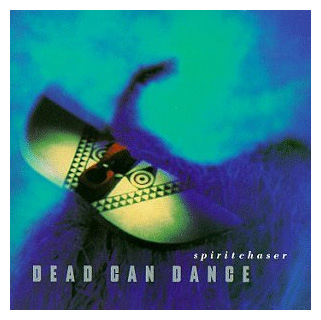 The Devilsound did just about everything I wanted it
to, when talking about the vast improvements over the on-board soundcards in
both my MAC and PC: it lowered the noise floor considerably, allowing far more
information retrieval, and did so in a way that was not anemic sounding, more so
like cleaning your windshield. On "Nierika",
the opening track on Dead Can Dance's Spiritchaser record, the song
begins with a quick panning of this spacey/helicopter-sounding pad effect,
followed by African drumming, which is reverse faded up into the soundstage (the
sound comes in incrementally). This is one of our acid tests for both imaging
and bass. The richness of the midrange was superbly delivered, and the lower
bass was striking and seemingly uncompressed. This is a difficult task for any
unit at this price. The track did not seem to be missing anything, except
perhaps a bit of the very bottom octave. This however, did not in anyway detract
from the power of the performance. The unit also managed to capture the
beautiful texture of voice of Margo Timmons
on "Lay it Down" the record of same name by the
Cowboy Junkies.
The Devilsound did just about everything I wanted it
to, when talking about the vast improvements over the on-board soundcards in
both my MAC and PC: it lowered the noise floor considerably, allowing far more
information retrieval, and did so in a way that was not anemic sounding, more so
like cleaning your windshield. On "Nierika",
the opening track on Dead Can Dance's Spiritchaser record, the song
begins with a quick panning of this spacey/helicopter-sounding pad effect,
followed by African drumming, which is reverse faded up into the soundstage (the
sound comes in incrementally). This is one of our acid tests for both imaging
and bass. The richness of the midrange was superbly delivered, and the lower
bass was striking and seemingly uncompressed. This is a difficult task for any
unit at this price. The track did not seem to be missing anything, except
perhaps a bit of the very bottom octave. This however, did not in anyway detract
from the power of the performance. The unit also managed to capture the
beautiful texture of voice of Margo Timmons
on "Lay it Down" the record of same name by the
Cowboy Junkies.
The Devilsound is a killer buy for the money. I am hard-pressed to find anything wrong enough to worry about. There may be a slight leanness to the lower octaves, but again that may also be the result of my system interacting with the Devilsound. I find it difficult to make blanket statements without sharing other possibilities in this game. Put it this way: if you're looking to upgrade performance and integrate your computer into your stereo system without any bells and whistles this unit should be high on your list. The Devilsound gets straight to the music, and does so without a blink. A big thumbs up and am looking forward to what they do next.

HRT (High Resolution Technologies) MusicStreamer+ USB DAC: $249.95
I've been anxiously awaiting an opportunity to hear the HRT MusicStreamer+ in my home system since I heard it at CES in Elite A/V Distribution's room. This small box was actually the inspiration for this round-up. I was surprised to walk into the room and hear Scot Markwell, now manager for Elite and former TAS regime member, speak so highly of a USB device, let alone experience a system set up by Markwell playing music from a MAC mini as a source! I've known Scot for years, and I have always considered him an analog addict. This was a sure sign of where things are going if ever I needed one. Now, of course I was not familiar with the system they were playing, only some of the components (a Plinius integrated for example) so I couldn't be sure what piece was doing what. I was however, very impressed with how musical the system sounded. The presence of the instruments in the room, and the detail I was hearing would have led me to believe I was listening to, at the very least, a decent CD deck on the front-end. Lo and behold all the music I heard there was provided via the MusicStreamer+. Naturally I had to get one and put it through our audible acid tests!
The unit is close in size to the Topaz: 5.1" x 2.1" x 1.2" (L x W x H) and is simple to set-up. There is no out-board power supply or wall wart, and the folks at HRT have also addressed the noise issues with regard to USB power. I will not presume to know exactly how they did it, but the noise floor is certainly low enough to let the music come through without constraint. Their explanation on themusic.com's website (where HRT products are sold) while brief, may give you a suitable description. It reads: There are no external power supplies to worry about because the Music Streamer+ derives its power from the USB buss while completely regenerating power for all its internal circuitry using a sophisticated set of proprietary circuits. Good enough for me. The internal DAC is the Texas Instruments PCM-1794, and there is no up-converting here. Seemingly similar in philosophy to the Devilsound, HRT is apparently focused on reproducing what is there rather than think about what might be on the recording should you increase the sample and bit-rates (again, there are arguments on both sides here).
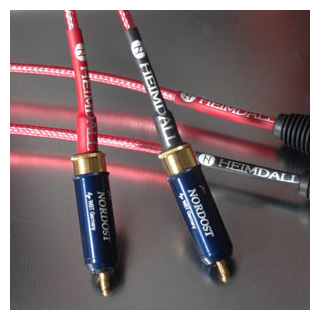
The lay-out is as straight forward as you can get: it has a USB input on one side and RCA jacks on the other for the output. The jacks are a great feature on this component as it lets you stick with interconnects you are familiar with. In my case I once again used the Nordost Heimdalls. The Streamer+ set up quickly without issue. Once I plugged it into my MAC or PC the computer recognized it, same as the Devilsound and Topaz, and we were listening in seconds. They ship the unit with a strip of rubber feet that you peel and stick on yourself. I suppose they do that in the event you might want to use something else to stick the unit to your rack or computer.
The things that struck me immediately about the MusicStreamer+ were the same characteristics that grabbed me at CES: clarity and depth of field. During the introduction and throughout the performance of Alicia Keys "No One" (off her As I am record) there is a static noise hovering over a pounding kick drum, meant to assimilate the sound of an old vinyl LP. Many artists and producers are doing this in order to create a vintage feel on present-day releases. The HRT accurately reproduced the crackle and pop of the noise without a hitch, not to mention allowing the dynamic punch of the kick to exist apart from the artificial noise. There was no congestion or overlapping of sounds in the stage. Many digital systems that I have heard masked this detail in the song. Some expensive, supposedly "reference" quality CD decks and other outboard DACs have failed to capture these subtle, fine points. Keys is a powerful performer, capable of translating emotions during both loud and quiet passages. The nuances in her vocals were capably reproduced. These details are vital for capturing her emotional delivery on a home stereo system. The kick drum was punchy and clear, and the air moved as if we were there in the studio with the band. Her music sounded uninhibited by the Streamer+, less a slight leanness in the lower octaves. The bass was not anemic by any means, simply lower in overall gain than I remember for this recording, which could have been the result of the coupling of the Nordost interconnects to the Streamer. Sometimes, as we all know, components act differently when mated with different cabling. Nonetheless, I did not feel like I was missing anything substantial enough to warrant a complaint.
Ani DiFranco is a favorite in this home. We love her music. She is stunning live, and if you haven't had the opportunity to see her, make a point to do so if you are a fan of her sound. Thankfully most of her recordings are also first rate, being a bit of an audio buff herself, so we get to enjoy her during critical listening sessions. Some folk artists, while you love their music, don't spend the time or effort on the sonic attributes of their recordings, and so the material is not suited for these types of tests. Ani loves to capture the transient attack on the pluck of her guitar. On "'tis of thee" (off Up Up Up Up Up Up, or UpX6 as it has come to be known) the guitar is the focal point of the intro. No other sounds exist for the first 20 seconds of the track, just DiFranco's guitar placed slightly behind the right speaker, her vocal then arrives dead center of the soundstage. The Streamer+ nailed the textural quality of her strums and voice, and brought the air of the studio into our listening space. The feeling of intimacy here is easy to muck up with poor information retrieval (aka resolution). There isn't much happening in terms of dynamic contrasts here but the sound is like fine wine: exquisite, while quickly disappearing into nothingness. The stillness of the background, the sonic backdrop, was also a testament to the Streamer's incredibly low noise floor. I chose this particular Ani record because there is spaciousness, a sort of blackness that only exists when the signal is free of dirt sometimes brought on by implanted hi-fi noise.
Ever plug a new piece of gear in and all of the sudden you're spending the day chasing the hum? No such worries here. Another compliment, and possibly the best one I can bestow upon the Streamer+ is its ability to show, almost immediately, the difference in performance amongst varying cables (both RCA and USB). After trying the Furutech SA-22 interconnects I got more punch in the lower octaves, and while they did not have the upper-end bloom and transparency of the Nordost, there was a sense of liveliness and presence to the sound that was very engaging. I am eager to hear more of their cables as the result of what I heard here. The biggest upgrade however came when I inserted the Polestar USB cable from the Locus Design Group. Now I know what my peers here at PFO are talking about! I have been admittedly very skeptical on whether or not an aftermarket cable could enhance the sound of a signal carried over USB. Well, I was dead wrong in my skepticism. The Polestar increased the speed of everything. I would love to comment on the increase in transient, blah blah blah, but the truth is everything got faster and more articulate! The marriage of the Streamer+ to the Polestar is something these companies need to consider, and it is a grand sonic combination; perhaps the best of the bunch here.
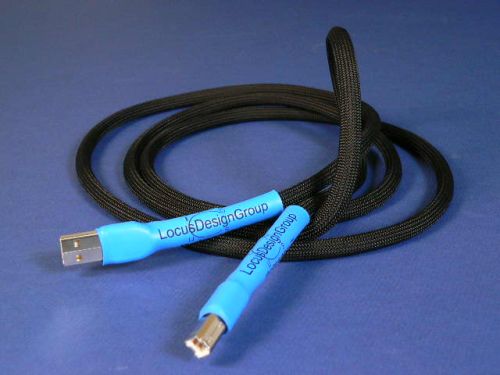
HRT has succeeded in building a product that will please audiophiles with a focus stretching far beyond the audiophile industry. There are, undoubtedly, people out there with boatloads of music imprisoned on hard drives just aching to play it all through their home stereos. Now they can do so without fuss, and without the worry of lost bits. Serious music lovers and philes should investigate the HRT Streamer+, as it was clearly designed to get through to the music, rather than get around it for a gimmick or effect.
All three DACs are highly recommended.
